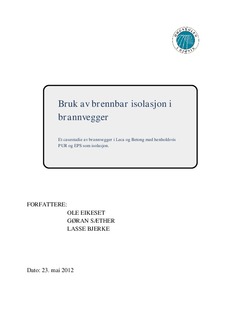| dc.contributor.author | Eikeset, Ole | |
| dc.contributor.author | Sæther, Gøran | |
| dc.contributor.author | Bjerke, Lasse | |
| dc.date.accessioned | 2012-07-31T07:12:52Z | |
| dc.date.available | 2012-07-31T07:12:52Z | |
| dc.date.issued | 2012 | |
| dc.identifier.uri | http://hdl.handle.net/11250/143427 | |
| dc.description.abstract | NORSK: Da TEK 10 tredde i kraft 01.07.2010 ble det en bevisstgjøring om at brennbar isolasjon kan nyttes
i en brannvegg dersom det blir dokumentert med prøving at isolasjonen ikke bidrar til brannen.
På denne bakgrunnen kom Bjørn Vik fra BMB (Brannvernsammarbeidet Mur og Betong) til
Høgskolen i Gjøvik november 2011. Vik opplyste om endringen i VTEK 10 og ønsket at vi lagde
en oppgave innenfor dette temaet.
Vi syntes dette hørtes meget interessant ut og valgte å ta for oss dette i Bacheloroppgaven vår.
Brannforsøkene skulle skje på brannlaboratoriet hos Weber Leca Lillestrøm. Ovnen som ble brukt
hadde en eksponeringsflate på 1x1m. Det ble bestemt at vi skulle gjennomføre uautoriserte
småskala forsøk, som eventuelt kan føre til autoriserte tester.
For å undersøke om brennbar isolasjon kan nyttes i brannvegger, gikk vi inn i et casestudie for å
svare på problemstillingen vår. Vi valgte i samarbeid med Bjørn Vik å teste vegger av Leca
Isoblokk 35 (med tilhørende produkter produsert av Weber Leca), samt sandwichvegger i betong.
Begge disse produktene med brennbar isolasjon, henholdsvis PUR og EPS.
Etter å ha gjennomført branntestene kunne vi konkludere med at veggen bygd opp av Leca
Isoblokk 35 med puss på begge sider holdt kravene for en EI 120 brannvegg.
I testene av sandwichelementene fikk vi alarmerende resultater. Vi testet to vegger som hadde
herdet i 17 og 18 dager samt en vegg som hadde herdet 8 måneder. Tidlig i forsøkene begynte
samtlige vegger å avskalle eksplosivt. Dette førte til at vi avslutningsvis stiller spørsmålstegn om
hvor lang herdetid som trengs før betongvegger er brannsikre. | no_NO |
| dc.description.abstract | ENGELSK: When the new update to TEK in Norway was applied 01.07.2010, the regulations opened for a
possibility to use flammable insulation in a firewall, thru approved experiments which documents
that the insulation will not contribute to the fire.
On this basis Bjørn Vik from BMB arrived (the Norwegian fire protection cooperation within
brick and concrete) to Gjøvik University Collage in November 2011. Vik told us about the
changes in VTEK 10.
We found this interesting and based our bachelor thesis on this. The fire tests took place at Weber
Leca`s fire laboratory in Lillestrøm. The fire oven we used had an exposure area of 1 m x 1 m.
The test we did qualifies for unauthorized small scale experiments, hopefully this will lead to
further experiments and authorized tests.
To investigate if flammable insulation can be used in fire walls, we did a case study to answer our
questions. We selected in collaboration with Vik to test Leca Isoblokk 35 manufactured by Weber
Leca. And concrete sandwich walls. Both of these products with flammable insulation.
After conducting the fire tests, we concluded that Leca Isoblokk 35 with plaster on both sides met
the requirements for a EI 120 firewall.
The concrete tests, gave us alarming results. The concrete walls (17 and 18 days old and one 8
months old wall) did all early in the tests spall explosive. This led us to questioning how long
curing time is necessary before a concrete wall is fire resistant. | no_NO |
| dc.language.iso | nob | no_NO |
| dc.subject | brannvegger | no_NO |
| dc.subject | brennbar isolasjon | no_NO |
| dc.subject | TEK 10 | no_NO |
| dc.title | Bruk av brennbar isolasjon i brannvegger: et casestudie av brannvegger i Leca og Betong med henholdsvis PUR og EPS som isolasjon | no_NO |
| dc.title.alternative | Combustible insulation in fire Walls: a casestudie of fire walls in Leca and concrete with PUR and EPS insulation | no_NO |
| dc.type | Bachelor thesis | no_NO |
| dc.subject.nsi | VDP::Technology: 500::Building technology: 530::Building, construction and transport technology: 532 | no_NO |
| dc.source.pagenumber | 93 | no_NO |
